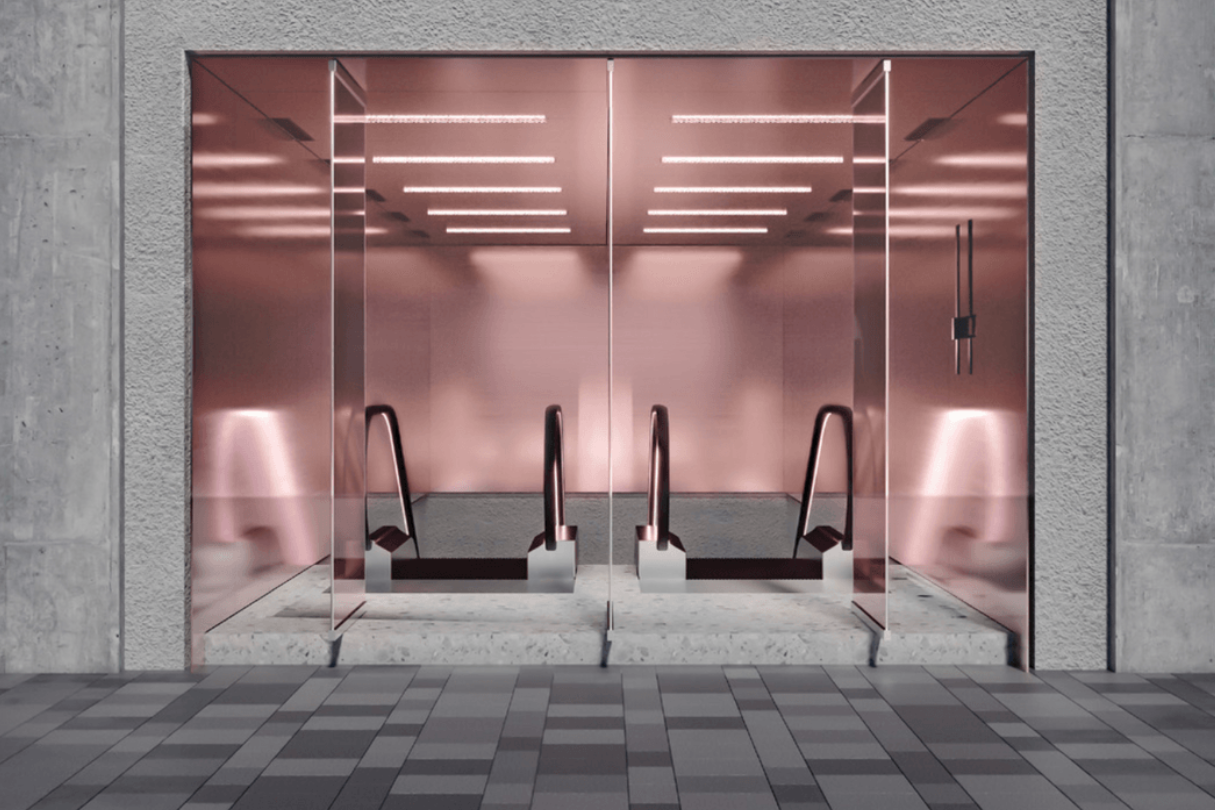Inside INS, a seven-floor commercial complex overlooking Shanghai’s century-old Fuxing Park that houses twelve nightclubs along with restaurants, esports arenas, and a comedy club, Alvin Leung, a 30-year-old Canadian visiting Shanghai in the summer of 2024, had a moment of cultural shock. In China, everything feels like a mall — even nightclubs, he thought.
INS, short for “Into Nothing Serious,” was founded by Dino Ying in 2021. Listening to him explain his concept for the space, it’s not surprising to learn that Ying is a Gemini — INS perfectly embodies the playful, fun-seeking, and youthful energy of his star sign. “To be honest, I just wanted to build a place for young people to have fun,” Ying said.
Embraced as a “Disneyland for adults” on the Chinese social media platform Xiaohongshu, INS offers a single general admission ticket priced at around 350 RMB (roughly 50 USD), which grants access to all clubs, each with complimentary drinks and music spanning genres from hip hop to techno, house, and bass music. Since its opening, this adult-centric destination has attracted a steady stream of both domestic and international party-goers, including Leung.

Tipsy, on the escalator up to another club, he felt like he was moving through a massive mall. “It didn’t really feel like each club within INS was a separate business. They all just kind of blur together, especially if you’re drunk,” Leung noted. “They seem like one giant club with different rooms playing different music.”
In fact, that’s exactly Ying’s vision for INS: each club is a distinct stage for a different music genre, mirroring the experience of EDM festivals like Tomorrowland or EDC, where ravers pay for general admission and move between stages.
“I felt like I was walking up [into] a normal Chinese mall because there’s so many malls in China. But combining [that] with clubs, this is something you won’t see outside of China,” said Leung.
A Gen Z-driven transformation

The concept of the mall is undergoing a transformation in China, driven by social media and evolving tastes amongst Gen Z and other young consumers. Commercial complexes like INS and TX Huaihai in Shanghai and Chayan Jiazu in Changsha are redefining what it means to be a mall, blending retail with culture and engagement in a way that resonates deeply with China’s digital-savvy youth.
Representing 27% of the population, Chinese Gen Z are shaping the future of China’s retail landscape. When it comes to making purchases, for this group of consumers individuality is currently taking precedence over utility and brand names. As online shopping becomes effortlessly accessible, it’s taking increasingly distinctive, non-standard offline experiences to capture the attention of these young, discerning consumers.
“Nowadays, businesses need to offer experiences that are worth having — experiences that foster social connections and User Generated Content. Only then can a place become a viral spot, the kind of place that draws and resonates with the young generation,” said Dickson Sezto, a real estate developer who brought the first Zara, Uniqlo, and Sephora stores to China before founding TX Huaihai.
Curating offline experiences
Since 1978, iconic sites like Beijing’s Wangfujing Department Store have symbolized China’s economic growth. In 2005, the South China Mall opened in the city of Dongguan. Then the biggest mall in the world, it grabbed attention around the globe. The mall was more than twice the size of the Mall of America, which remains the biggest shopping center in the United States. As of the end of 2022, China had nearly 6,700 malls, each covering over 30,000 square meters. In 2023 alone, 400 new malls were unveiled.
However, despite this boom, the retail landscape is shifting as the growing middle class increasingly turns to online shopping. According to real estate firm CBRE, existing malls are struggling to survive. More than 10 percent of retail space in second-tier cities like Qingdao, Shenyang, and Tianjin remains vacant, and ambitious developments, like a Pentagon-shaped mall near Shanghai, have been left abandoned.
“The development of commercial real estate in China lacks planning and is rather chaotic. It largely depends on who controls the land and the government’s agenda, which leads to an unequal distribution of commercial spaces,” explained Sezto. “There’s no clear strategy or balance, and people rush to build whatever seems profitable, resulting in an oversupply of commercial properties across cities, from second-tier to even fourth-tier locations.”
For businesses, the solution nestles in recapturing the purpose of retail spaces through curated cultural experiences. A few blocks away from INS in Shanghai, the TX Huaihai Youth Energy Center reimagines the retail experience on Middle Huaihai Road, one of the city’s iconic shopping streets. As a pioneer in “Curetail” (curated retail), it offers a mindful, open space where brands and artists showcase their work in an innovative setting. The center blends retail with entertainment, dining, and nightlife, creating a hub for Gen Z. Spaces for international brands like Nike Style and HUMAN MADE, alongside stores for local Chinese designers, art exhibitions, pop-up shops, and two nightclubs, have helped make TX Huaihai into a social media sensation.
Meanwhile in Changsha, the Chayan Jiazu (茶颜家族) complex has emerged as a must-visit landmark for young people, drawing steady streams of visitors captivated by the social media craze surrounding Chayan Yuese (茶颜悦色), a local milk tea chain. For Gen Z consumers this “new-style tea” brand has become synonymous with the city. Since Chayan Yuese opened its first tea shop in 2013 it has evolved into an empire encompassing five brands: the original milk tea chain, the lime-themed Good MoNing (古德墨柠), the café YuanYang Coffee (鸳央咖啡), cocktail concept Day and Night Poetry Tea & Art Bar (昼夜诗酒茶·艺文小酒馆), and the fine tea-focused Chayan Xiao Shenxian Tea House (茶颜·小神闲茶馆). Chayan Jiazu brings these brands together in a complex that’s half beverage-focused mall, half tea museum, and offers milk tea, contemporary twists on traditional Chinese tea, cocktails, karaoke, and more.

“The names of these stores reflect a traditional Chinese style, transforming Chayan Yuese into more than just a food and beverage brand. It feels like a cultural and entertainment experience,” said Longzhu Bai, a 26-year-old woman who visited Changsha from Hong Kong in November 2024.
A space for everyone to let loose
Back in Shanghai, tourists also form an important part of INS’s clientele. According to Ying, today 40% of INS customers are out-of-towners. Social media buzz amplifies its appeal, with videos and posts showcasing its unique vibe. There’s something about INS’s culture of being “into nothing serious” that really resonates with this generation’s desire for relief from societal pressures, embodying a carefree spirit that appeals to stressed-out young people seeking a sense of liberation and cultural connection.
“Gen Z faces immense societal pressures, from tough job markets to challenging work environments, yet they remain free-spirited. They need a place to get loose and feel genuinely happy,” Ying shared.
43-year-old Ying, who also owns a gaming company and an esports company, speaks about INS with unmistakable exuberance. Describing it as his “child,” he sees it as the result of years of internal conflict between his profit-driven businessman persona and his idealist side — what he calls his “creative Gemini energy.”

Part of INS’s uniqueness stems from Ying’s deep understanding of rave culture’s PLUR (Peace, Love, Unity, Respect) spirit. The founder has raved at festivals like Tomorrowland, EDC, and Ultra for more than a decade, and is passionate about the inclusive atmosphere he has encountered at these events. He shares a memorable experience of watching festivalgoers moving in unison to a set by Dimitri Vegas and Like Mike at Tomorrowland. The sight gave him a feeling of unity, leading to the realization that no matter one’s race, age, or gender, we will simply want to come together to dance and enjoy the moment.
Ying attempts to pass this ethos on to the Chinese clubbing scene, and INS stands out with its general admission concept and thoughtful touches such as posters promoting women’s empowerment, gender equality, and care for seniors. He places a strong emphasis on employee training and attention to detail. For instance, if a general admission customer uses all their drink tickets but wants one more, the venue might offer a free drink. And any security guard ignoring a guest in distress — like someone passed out from drinking — will be immediately dismissed.
By carefully curating experiences, INS — and other Chinese businesses redefining what it means to be a mall — are increasingly making a name for themselves, both at home and abroad. In August 2024, Kenny Li, a 27-year-old Chinese New Zealander living in Australia, made INS one of his first stops during a trip to Shanghai, after hearing about it from friends and seeing it online. “I wanted to see what clubbing was like in Shanghai,” he shared. “And I think INS is such a cool concept.”
Banner graphic by Haedi Yue.
















